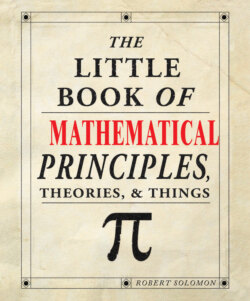Читать книгу The Little Book of Mathematical Principles, Theories & Things - Robert Solomon - Страница 18
На сайте Литреса книга снята с продажи.
6th century BC Global The Golden Ratio
ОглавлениеA ratio of lengths that occurs in mathematics, nature, and art.
_______________
The sides of a rectangle are in the golden ratio if, when you remove a square, the new rectangle is similar to the original one. The golden ratio is a number that is defined geometrically but which occurs in many other contexts.
The diagram shows the situation. The sides are r and 1. If we remove a square of side 1 by cutting along the dotted line, we now have a rectangle which is 1 by r – 1.
This is similar to the original rectangle. Hence the ratios r/1 and are equal.
Putting , we obtain:
r2 – r – 1 = 0.
The positive solution of this quadratic equation is the value of r.
This ratio is called the golden ratio, or golden section, and it is written as φ (pronounced phi). Like so many other things, its discovery is credited to the Pythagoreans.
This illustrates how the golden rule is defined.
The exact value of φ is and an approximate value is 1.618.
Here are some of the occurrences of the ratio:
• In mathematics, it occurs in the pentagon and the pentagram (five-pointed star) and the Penrose tiling. The ratio of successive terms of the Fibonacci sequence tends to φ
• In nature, the shell of the Nautilus snail and the pattern of sunflower petals are said to exhibit the ratio.
• In art, the façade of the Parthenon in Athens is reputed to be a rectangle in the golden ratio though this is controversial. Renaissance artists were very interested in the ratio and it appears in many paintings. Luca Pacioli, the inventor of double-entry bookkeeping, wrote a book on the ratio called De divina proportione, illustrated by Leonardo da Vinci. Composers such as Béla Bartok and Claude Debussy deliberately used the ratio in their music.
The ratio of 1 mile to 1 kilometer is 1.609, very close to 1.618, but that is probably just a coincidence.
See: Fibonacci Numbers, pages 54–55; Tessellations, pages 68–69.
